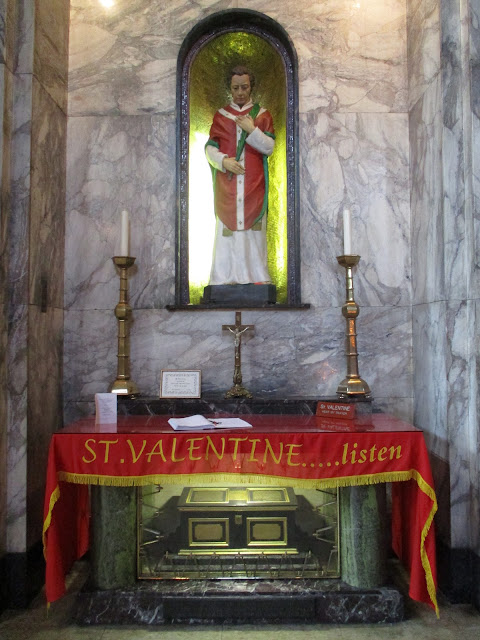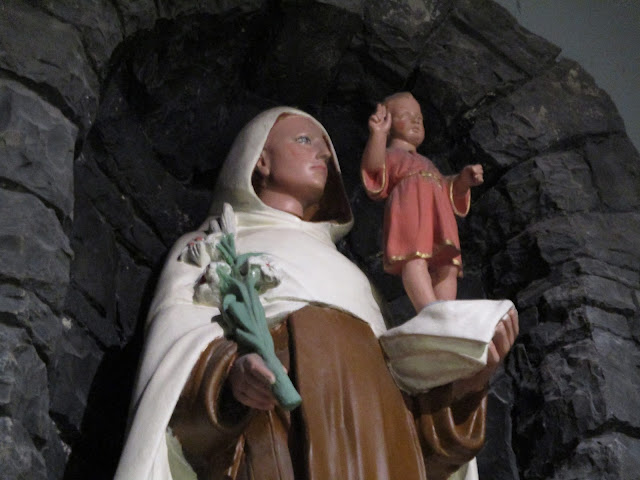Saint Albert and Infant Jesus
Dear Reader,
A candle was lit for your intentions at St Albert's Well in White Friar Street Church (Church of Our Lady of Mount Carmel & Shrine of St Valentine), Dublin.
St Albert of Sicily
St Albert was born in Trapani in Sicily about 1240. Some seventeen years later he entered the Carmelite Order and died in 1306. His feast day is celebrated on August 7th.
Preaching and miracles
This Sicilian Carmelite Friar distinguished himself for his dedication to mendicant preaching, the notoriety of his miracles and his purity of life. During the years 1280 and 1289, St Albert ministered in Trapani.
Shortly afterwards he relocated to Messina where he gathered thousands with his preaching and miracles. In 1296 Albert was prior provincial of the Carmelite Province of Sicily.
Albert is said to have written books, though none survive, and he is regarded as patron saint of Carmelite studies. The saint has been attributed for the 1301 lifting of the siege in Messina that could have seen hundreds die from starvation had it not been for his intervention. Messina was under siege and blockaded after Duke Robert of Calabria entered. St Albert responded to the pleas for succor and went on to celebrated Mass as a plea for the deliverance of God. Once he finished three ships loaded with grain ran the blockade, thus saving Messina as Duke Robert lifted the siege.
The saint eventually died in a convent in Messina.
Albert was among the first Carmelite saints to be venerated by the Order, of which he was later considered a patron or protector - (or "father") - a title he shared with another saint of his time, Angelo of Sicily.
In the 16th century, it was decided that every Carmelite church would dedicate an altar in his memory. Later Carmelite saints Teresa of Avila and Mary Magdalene de' Pazzi honored him.
St Teresa of Avila asked a Dominican (possibly Diego de Yanguas) to translate an old biography of St Albert from Latin, which he did. She then arranged that the translation be published by Don Teutonio de Braganza along with her book "The Way of Perfection." Both books were published in February 1683, four months after Teresa's death.
Artworks
In the late 15th century Sforza Book of Hours we see St Albert preaching and healing.
In the Cathedral at Prato in Italy, Albert's image occupies a prominent place on the end wall of the choir beside the cycle of the lives of SS Stephen and John the Baptist. The work is by Fra Filippo Lippi and was composed while he was in safety in Prato from 1452-1465. Lippi was also a Carmelite.
The Carmelite artist Giovanni Maria da Brescia depicted Albert in a print. The saint is pictured second from the right at the bottom, alongside other saints.
Hieronymus Wierix portrayed the adoration of God and veneration of Mary by Saint Albert and his "companion saint", the Martyr Saint Angelus.
Miraculous cure
St Albert was miraculously cured by water given to him by Our Lady in a vision. He is renowned for his devotion to the Infant Jesus and his healing ministry by means of water blessed in honor of the Blessed Virgin.
Fr Spratt, O. Carm. who spent some time in St Albert's monastery in Spain, brought devotion to the Saint back to Dublin and was responsible for the inauguration of the well, now commonly known as "Albert's Well."
Many people visit the shrine and well to avail of the waters blessed in honor of the Saint. St Albert's Wells in Dublin and Agrigento, Sicily, are said to bring healing and peace in mind and body to those who avail of the waters. I can attest to the truth of this during my pilgrimage to his holy shrine in Dublin.
Prayer to Saint Albert
A spotless lily of purity, glorious Saint Albert, through the merits of thy ever perfect stainlessness, which rendered thee in life so dear to God and made thee be called "Saint" by the angels shortly after death, we pray thee with our whole heart to obtain for us grace whereby we may become able through sincere repentance to clothe ourselves anew with the garment of holiness, lost by sin; and to wear it ever unsullied until death.
May we, by imitating as far as in us lies, the innocence of thy holy life, reach in safety our heavenly home and receive from God that prize, which He has prepared for those who love Him.
Pater
Ave
Gloria
(Pray the Our Father, a Hail Mary and Glory be)
Our Father
Our Father, Who art in heaven, hallowed by Thy Name; Thy kingdom come, Thy Will be done, on earth as It is in heaven. Give us this day our daily bread, and forgive us our trespasses, as we forgive those who trespass against us; and lead us not into temptation, but deliver us from evil. Amen.
Hail Mary
Hail Mary, full of grace, the Lord is with thee; blessed art thou among women, and blessed is the Fruit of thy womb, Jesus; Holy Mary, Mother of God, pray for us sinners, now and at the hour of our death, Amen.
Glory be
Glory be to the Father, and to the Son, and to the Holy Spirit; as it was in the beginning, is now, and ever shall be, world without end, Amen.
Photographs by Catherine Nicolette
Artwork with thanks to Idle Speculations blogspot
IDLE SPECULATIONS: Saint Albert of Sicily (Trapani) (idlespeculations-terryprest.blogspot.com)
.









